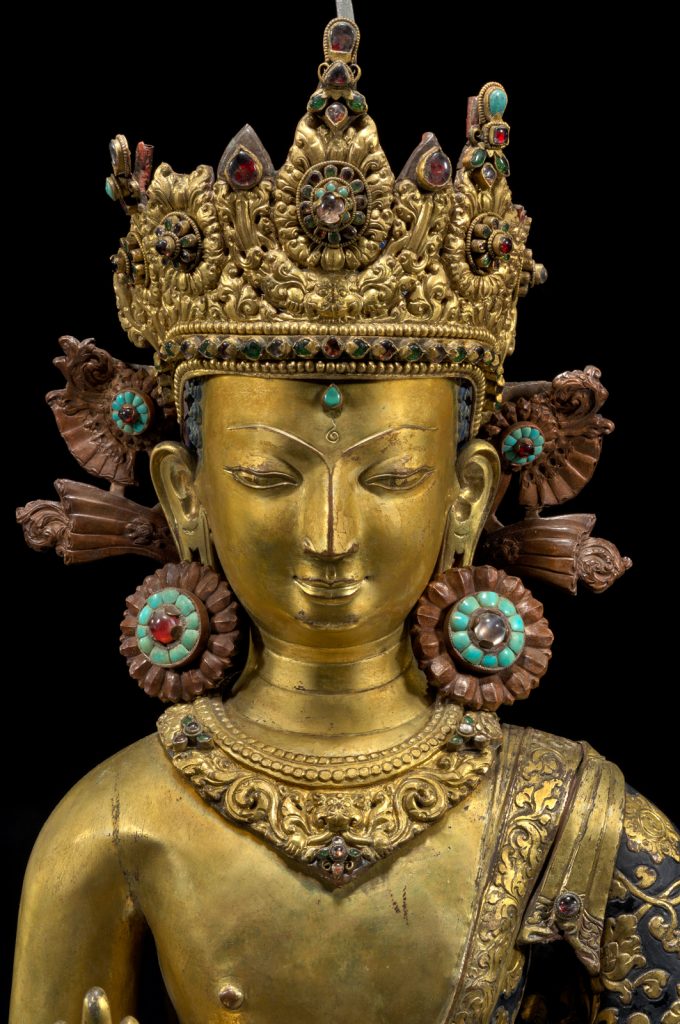In both Buddhist and Hindu traditions, devotional objects seek to bring the viewer and worshiper into tranquil and compassionate states, aimed at getting the mind into concentration, samadhi, and closer to the sublime. In The Benevolent Beings: Buddhas and Bodhisattvas from South and Southeast Asia, currently being exhibited at Pasadena’s Norton Simon Museum until February 19, 2024, the interplay between the objects of these two religions is on full display. Inspired by assistant curator Lakshika Senarath Gamage’s personal experiences growing up in Sri Lanka, Gamage organized the show to “speak to the continuity of devotional engagement with objects that remain essential to healing and tranquility” in these two traditions.
In contrast to the monumental deities that make up part of Norton Simon’s permanent collection, many of the objects exhibited in Benevolent Beings reflect small-scale everyday devotional objects, whether previously installed in temples or possibly kept in people’s homes—some still bearing traces of their original intended use. The exhibition’s design evokes South Asia’s 13th- to 18th-century Buddhist temples, and the three galleries are organized to guide visitors to increasingly sacred objects as they progress through the exhibition, encouraging slow and deliberate contemplation and the feeling of interaction and interconnection between the object and the viewer. As a visitor, I felt encouraged to slow down and look closely to immerse myself in the values shared across these two dharmas. The challenge of this exhibition is to keep in mind that these are devotional, votive objects and not just art items. With thoughtful and meaningful curation, the exhibition aims to be accessible to both religious practitioners as well as the lay art-appreciating public.
Visiting this exhibition as a scholar of comparative religions, I am reminded that Buddhism has always existed in the context of other traditions. We recall that it was first introduced into the region in the 4th century CE in conjunction with several types of pre-Hindu religions, Vedic beliefs, and local indigenous animistic cults. The Buddhas and bodhisattvas in this exhibition highlight the syncretic nature of the artistic exchanges between pre-Hindu and Buddhist and, in some cases, Islamic, or Persian, art and culture. The art exhibited in these galleries retains regional distinctions yet showcases a sense of cosmopolitan artistic interplay.
The first gallery features a selection of mythical bird-shaped incense burners from South India, including Censer in the Form of a Mythical Bird, designed to either venerate the Buddha or to please the senses of the Hindu gods. It also includes a Buddhist Manuscript with Covers, from northern Thailand or Myanmar, and Hanging with Nepali Stupas, a cotton scroll, which most likely originated in India. Most of the objects in this gallery were commissioned by either laypeople or religious patrons who aimed to accumulate merit. By commissioning works of art, patrons believe that they acquired an abundance of blessings and protection, a practice that continues to this day. The gallery also includes a selection of bodhisattvas and merciful gods, including Ganesha with the Hindu Triad, a 10th-century sculpture of Ganesha, a beloved Hindu “remover of obstacles,” as well as the god Vishnu.
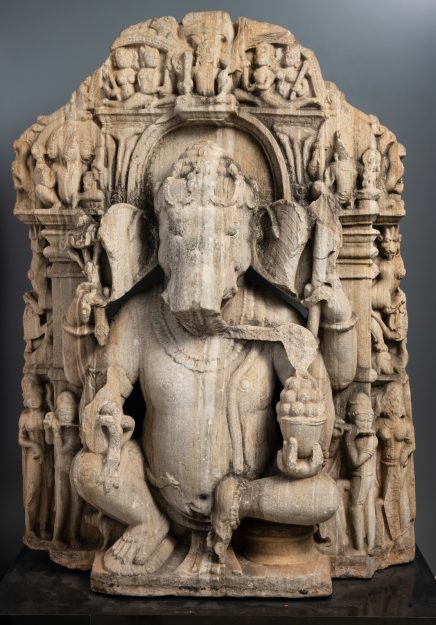
In both the Buddhist and Hindu traditions, elephants are sacred symbols. In Buddhism, elephants are the guardians of the Buddha and Earth’s energy and represent physical stress that also indicates mental stress and responsibility. Similarly, in Hinduism, elephants also represent intellectual and mental strength. Further, the notion of mental strengths and knowledge is exemplified in the Bodhisattva Manjusri, a bodhisattva of wisdom, who generally holds a sword in one arm to cut off all delusion. Notably, Vishnu often appears in Buddhist temples to protect visitors in sacred spaces. Gamage explains that it is not unusual for Hindu gods to be placed near the Buddha. Placing Buddha close to Vishnu allows the worshipers to combine blessings for earthly matters with a focus on transcendent values, further underscoring the notion of religious interrelation. Buddha with Two Bodhisattvas, a triad of the Buddha with two bodhisattvas, can be perceived as having only Buddhist relevance. Here, the idea of compassion is underscored with Avalokiteshvara, the bodhisattva of infinite compassion, on the Buddha’s right, and Vajrapani, the earliest protector and guide of Buddhism, on his left. However, we should note that Vajrapani shares his origin with the Vedic deity Indra, also the king of gods in Hinduism.
Another significant art object is the statue Buddha, from 20th-century Thailand, which features the Buddha standing on a lotus pedestal placed on a mythical bird. It appears that artisans possibly combined the Buddha with Garuda, which in Hindu mythology is the bird and the mount of Vishnu. While the Buddha does not have a similar carrier, since he is not divine but human, some Vishnu devotees consider the Buddha Vishnu’s avatar or a manifestation of the deity on earth. The interplay of the traditions can also be observed in Descent of the Buddha. Here, we see Hindu creator Brahman, who is positioned on the Buddha’s right, and Indra, the king of gods, on the left. In Descent, note how the depiction of the Buddha is made to look much larger than his Hindu counterparts, illustrating the concept of hierarchical scale, or hierarchical proportion, displaying the sensibilities of the environment where it was created and the weight of importance given to the separate traditions by the image’s creator, Tibetan artist Phurbu Tshering of Chamdo.
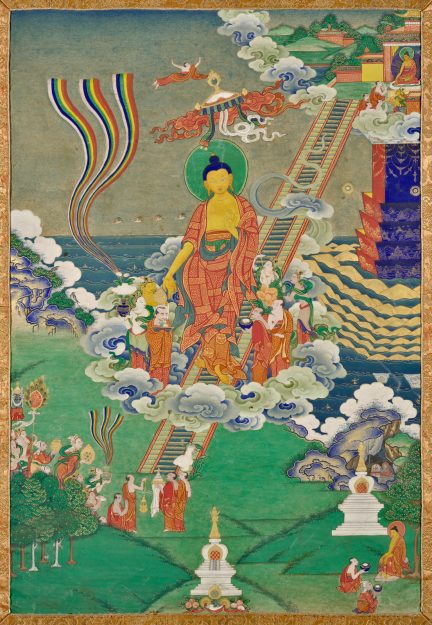
The second gallery aims to convey the concept of multiple Buddhist heavens and evokes the same architecture as seen in South Asian Bodhi shrines. A Bodhi tree is placed in the center and is surrounded by four sitting Buddhas or four stupas or four objects. This setting allows practitioners to circumambulate the Buddhas (or four stupas or four objects) just as they would have done in the Bodhi shrines. For the general public, it is a space to encounter each individual Buddha within a frame of the Bodhi tree to appreciate the iconography, the material, and the quality of the art. This approach considers different audiences and makes it accessible to anybody without being didactic in its application.
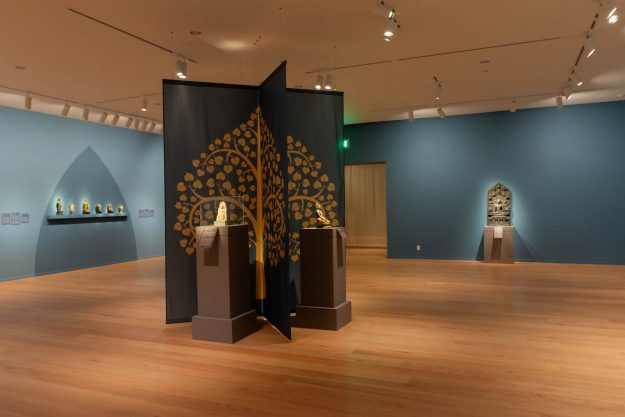
Along the second gallery’s back wall viewers encounter Stele with Buddhas and Bodhisattvas—a solitary Buddha dated to c. 1100 India, of either West Bengal or Bangladesh origin. Carved from a chlorite stone, it glitters and shines in the light, allowing devotees to experience the immediacy of this visual encounter. The representation of the Buddhist cosmos in the stupa and the three-dimensional mandala brings forth the idea of symbolic meaning that serves not only as a meditation guide but also as protection against negative forces. Stupas illustrate the earthly realm (through their base), as well as nirvana (the jeweled pinnacle), or the ultimate goal of cessation of death and rebirth. The three-dimensional mandala, in turn, represents a cosmological map of the universe. The symbolic meanings of these images serve not only as meditation guides but also as forms of protection against negative forces. It needs to be noted that this lotus mandala is meant to commemorate the Hindu god Vishnu, the preserver of the universe, even though mandalas are most commonly used for Buddhist symbolism. Visitors will note the confluence of Buddhist and Hindu symbols: at the left side of the Buddha is Lakshmi, a goddess of wealth, prosperity, fertility, and abundance, and on the right is Sarasvati, a goddess of education, creativity, and music.
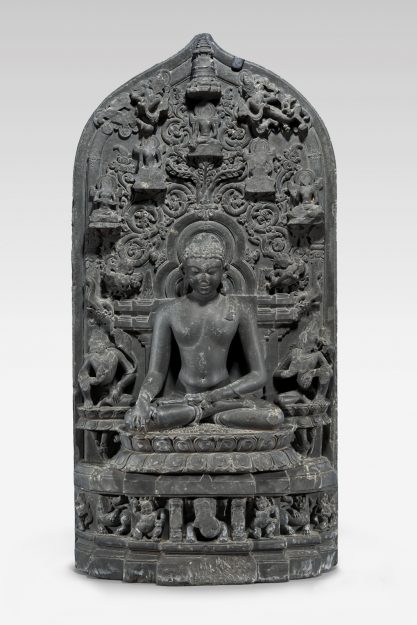
Another example of this interplay is the Lotus Mandala with Eight Mothers, from 18th-century Nepal, composed of a bronze cosmic diagram that features eight female deities, known collectively as the Ashthamatrika, which is deeply rooted in Hinduism. These Eight Mothers symbolize the connection between the divine and their maternal forces of creation. Another example is Railing Pillar: Female Deity, which also serves as a prototype within both Buddhist and Hindu contexts.
The third and final gallery has two benches for visitors to sit down and relax, or meditate, and includes my other favorite object—Buddha Shakyamuni in Meditation, a solitary Buddha placed in the front of the gallery. A sculpture of a solitary Buddha dates to 6th-century Sri Lanka. Here, the Buddha manifests a feeling of deep meditation and invites visitors to partake in meditation as well.
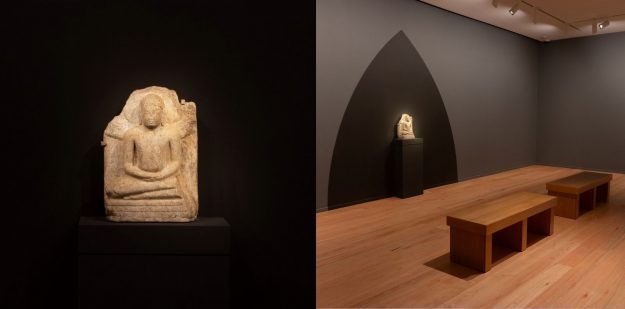
Notably, this gallery provides a space for tranquility and serenity but also underscores the idea of cultural interplay and productive coexistence. Benevolent Beings explores the links between Hinduist and Buddhist traditions; their shared history, their shared liturgy, and the compassion and sublime attitudes they both value above all else. It’s a must-see exhibit for those who wish to engage in openness of religious and cultural interplay that transcends territorial boundaries, ideologies, and biases, presenting the spiritual as a vast and interconnected web imbued with wisdom for those who are willing to stop for a moment and take in what’s around them.
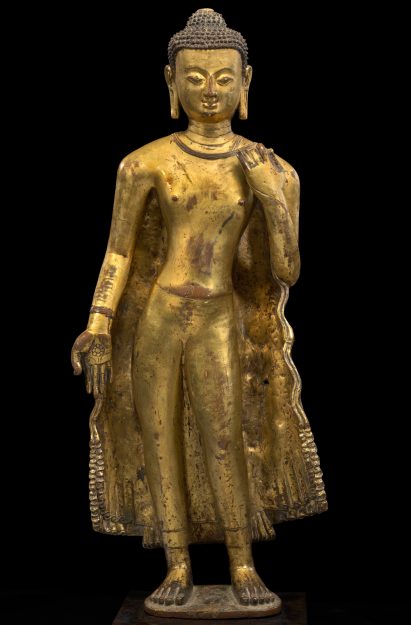
Thank you for subscribing to Tricycle! As a nonprofit, we depend on readers like you to keep Buddhist teachings and practices widely available.
